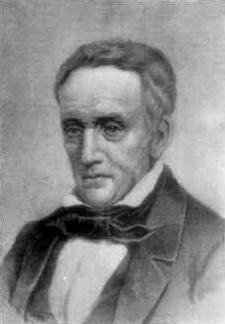John Reynolds (John Reynolds)

John Reynolds (February 26, 1788 – May 8, 1865) was a United States politician from the state of Illinois. He was one of the original four justices of the Illinois Supreme Court, 1818–1825, a member of the Illinois House of Representatives from 1826–1830, 1846–1848, and 1852–1854 (when he was Speaker of the House), and the 4th Illinois Governor from 1830–1834. He also represented Illinois in the United States House of Representatives, 1834–1837 and 1839–1843. Reynolds was born in Montgomery County, Pennsylvania. His father, Robert Reynolds and his mother, née Margaret Moore, were both natives of Ireland, from which country they emigrated to the United States in 1785, arriving first at Philadelphia. When Reynolds was about six months old, his parents emigrated with him to Tennessee, where many of their relatives had already located, at the base of the Copper Ridge Mountain, about 14 miles (23 km) northeast of the present city of Knoxville. After experiencing harassment from Native Americans fighting encroachment by white settlers upon their territory, the Reynolds moved into the interior of the state. They were poor, and brought up their children to habits of manual industry. In 1800 the family moved to Kaskaskia, Illinois, where Reynolds spent most of his childhood. As part of his upbringing, he adopted the principle and practice of total abstinence from intoxicating liquors. In 1807 the family made another move, this time to the Goshen Settlement, at the foot of the bluffs overlooking the Mississippi River southwest of Edwardsville.
At the age of twenty, John Reynolds attended college for two years near Knoxville, Tennessee, where he had relatives, taking courses in classical studies. He then studied law in Knoxville, but health problems forced him to return home to Illinois. In the fall of 1812 he was admitted to the bar at Kaskaskia. About this time he also learned the French language, which he regarded as being superior to all others for social intercourse. With the ranks of private and orderly sergeant, Reynolds served as a scout in campaigns against the western Native Americans during the War of 1812. For this service, Reynolds became known as the “Old Ranger.” In 1814, Reynolds opened a law office in the old French village of Cahokia, then the county seat of St. Clair County. In the fall of 1818 he was elected an associate justice of the Illinois Supreme Court by the Illinois General Assembly. In 1818, he was an unsuccessful candidate for election to the United States Senate. In 1826, he was elected a member of the Illinois House of Representatives for the first time, serving until 1830. Although aligning himself with the Jacksonian Democrats, his moderation earned him respect from both pro-Jackson and anti-Jackson factions. In August 1830, John Reynolds was elected governor of Illinois and took office on December 6. The most significant event of his administration was the Black Hawk War in 1832. He called out the militia, and was field commander, often appearing in person on the battle-grounds. He was recognized by U.S. President Andrew Jackson as Major-General, and was authorized to make treaties with the Indians. On November 17, 1834, Reynolds resigned as governor, having been elected to the United States House of Representatives for the Twenty-third Congress to fill the vacancy caused by the death of Charles Slade. He was reelected to the Twenty-fourth Congress, serving from December 1, 1834 to March 3, 1837. He was an unsuccessful candidate for reelection in 1836 to the Twenty-fifth Congress. He was subsequently elected to the Twenty-sixth and Twenty-seventh Congresses, serving from March 4, 1839 to March 3, 1843. In 1837, while out of Congress and in company with a few others, he built the first railroad in the Mississippi Valley, about six miles (10 km) long, leading from his coal mine in the Mississippi bluff to the bank of the river opposite St. Louis. Not having the funds to purchase a locomotive, the railroad was operated by horse-power. The next spring, however, the company sold out at great loss.
In 1839 John Reynolds was appointed one of the Canal Commissioners and traveled to Philadelphia to raise funds for that purpose. During that year, he also made a tour of Europe with his wife and introduced the noted Mormon Prophet, Joseph Smith to President Martin Van Buren. Reynolds was elected in 1846 for one term as a member of the Illinois House of Representatives from St. Clair County. He was again elected in 1852, serving as Speaker of the House. In 1860, aged and infirm, he attended the Democratic National Convention in Charleston, South Carolina, as an anti-Douglas Delegate, instead supporting John C. Breckinridge in the U.S. presidential election. He was married twice, but had no children. He died in Belleville in May 1865, just after the close of the Civil War, and is interred at Walnut Hill Cemetery in Belleville.
Born
- February, 26, 1788
- USA
- Montgomery County, Pennsylvania
Died
- May, 05, 1865
- USA
- Belleville, Illinois
Cemetery
- Walnut Hill Cemetery
- Belleville, Illinois
- USA



